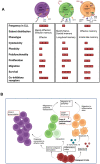Depletion of polyfunctional CD26highCD8+ T cells repertoire in chronic lymphocytic leukemia
- PMID: 36707896
- PMCID: PMC9881277
- DOI: 10.1186/s40164-023-00375-5
Depletion of polyfunctional CD26highCD8+ T cells repertoire in chronic lymphocytic leukemia
Abstract
Background: CD8+ T cells play an essential role against tumors but the role of human CD8+CD26+ T cell subset against tumors, in particular, haematological cancers such as chronic lymphocytic leukemia (CLL) remains unknown. Although CD4+CD26high T cells are considered for adoptive cancer immunotherapy, the role of CD8+CD26+ T cells is ill-defined. Therefore, further studies are required to better determine the role of CD8+CD26+ T cells in solid tumors and haematological cancers.
Methods: We studied 55 CLL and 44 age-sex-matched healthy controls (HCs). The expression of CD26 on different T cell subsets (e.g. naïve, memory, effector, and etc.) was analyzed. Also, functional properties of CD8+CD26+ and CD8+CD26- T cells were evaluated. Finally, the plasma cytokine/chemokine and Galectin-9 (Gal-9) levels were examined.
Results: CD26 expression identifies three CD8+ T cell subsets with distinct immunological properties. While CD26negCD8+ T cells are mainly transitional, effector memory and effectors, CD26lowCD8+ T cells are mainly naïve, stem cell, and central memory but CD26high T cells are differentiated to transitional and effector memory. CD26+CD8+ T cells are significantly reduced in CLL patients versus HCs. CD26high cells are enriched with Mucosal Associated Invariant T (MAIT) cells co-expressing CD161TVα7.2 and IL-18Rα. Also, CD26high cells have a rich chemokine receptor profile (e.g. CCR5 and CCR6), profound cytokine (TNF-α, IFN-γ, and IL-2), and cytolytic molecules (Granzyme B, K, and perforin) expression upon stimulation. CD26high and CD26low T cells exhibit significantly lower frequencies of CD160, 2B4, TIGIT, ICOS, CD39, and PD-1 but higher levels of CD27, CD28, and CD73 versus CD26neg cells. To understand the mechanism linked to CD26high depletion, we found that malignant B cells by shedding Galectin-9 (Gal-9) contribute to the elevation of plasma Gal-9 in CLL patients. In turn, Gal-9 and the inflammatory milieu (IL-18, IL-12, and IL-15) in CLL patients contribute to increased apoptosis of CD26high T cells.
Conclusions: Our results demonstrate that CD26+ T cells possess a natural polyfunctionality to traffic and exhibit effector functions and resist exhaustion. Therefore, they can be proposed for adoptive cancer immunotherapy. Finally, neutralizing and/or inhibiting Gal-9 may preserve CD26highCD8+ T cells in CLL.
Keywords: Adoptive T cell therapy; Galectin-9; MAIT cells; T cells exhaustion.
© 2023. This is a U.S. Government work and not under copyright protection in the US; foreign copyright protection may apply.
Conflict of interest statement
The authors declare that they have no competing interests.
Figures







Similar articles
-
Polyfunctional CD8+CD226+RUNX2hi effector T cells are diminished in advanced stages of chronic lymphocytic leukemia.Mol Oncol. 2025 May;19(5):1347-1370. doi: 10.1002/1878-0261.13793. Epub 2025 Jan 7. Mol Oncol. 2025. PMID: 39777847 Free PMC article.
-
Expanded antigen-experienced CD160+CD8+effector T cells exhibit impaired effector functions in chronic lymphocytic leukemia.J Immunother Cancer. 2021 Apr;9(4):e002189. doi: 10.1136/jitc-2020-002189. J Immunother Cancer. 2021. PMID: 33931471 Free PMC article.
-
Human CD26high T cells elicit tumor immunity against multiple malignancies via enhanced migration and persistence.Nat Commun. 2017 Dec 6;8(1):1961. doi: 10.1038/s41467-017-01867-9. Nat Commun. 2017. PMID: 29213079 Free PMC article.
-
Functional Signatures of Human CD4 and CD8 T Cell Responses to Mycobacterium tuberculosis.Front Immunol. 2014 Apr 22;5:180. doi: 10.3389/fimmu.2014.00180. eCollection 2014. Front Immunol. 2014. PMID: 24795723 Free PMC article. Review.
-
Abnormal T-cell function in B-cell chronic lymphocytic leukaemia.Leuk Lymphoma. 2003 Mar;44(3):383-9. doi: 10.1080/1042819021000029993. Leuk Lymphoma. 2003. PMID: 12688308 Review.
Cited by
-
Exploring the role of galectin-9 and artemin as biomarkers in long COVID with chronic fatigue syndrome: links to inflammation and cognitive function.Front Immunol. 2024 Sep 25;15:1443363. doi: 10.3389/fimmu.2024.1443363. eCollection 2024. Front Immunol. 2024. PMID: 39386210 Free PMC article.
-
Bipotential B-neutrophil progenitors are present in human and mouse bone marrow and emerge in the periphery upon stress hematopoiesis.mBio. 2024 Aug 14;15(8):e0159924. doi: 10.1128/mbio.01599-24. Epub 2024 Jul 16. mBio. 2024. PMID: 39012145 Free PMC article.
-
Broadening the horizon: potential applications of CAR-T cells beyond current indications.Front Immunol. 2023 Nov 27;14:1285406. doi: 10.3389/fimmu.2023.1285406. eCollection 2023. Front Immunol. 2023. PMID: 38090582 Free PMC article. Review.
-
Prognostic Potential of Galectin-9 mRNA Expression in Chronic Lymphocytic Leukemia.Cancers (Basel). 2023 Nov 11;15(22):5370. doi: 10.3390/cancers15225370. Cancers (Basel). 2023. PMID: 38001630 Free PMC article.
-
CD73: a new immune checkpoint for leukemia treatment.Front Immunol. 2025 Mar 6;16:1486868. doi: 10.3389/fimmu.2025.1486868. eCollection 2025. Front Immunol. 2025. PMID: 40114928 Free PMC article. Review.
References
-
- Ahrén B, Hughes TE. Inhibition of dipeptidyl peptidase-4 augments insulin secretion in response to exogenously administered glucagon-like peptide-1, glucose-dependent insulinotropic polypeptide, pituitary adenylate cyclase-activating polypeptide, and gastrin-releasing peptide in mice. Endocrinology. 2005;146:2055–2059. - PubMed
-
- Abbott CA, Baker E, Sutherland GR, McCaughan GW. Genomic organization, exact localization, and tissue expression of the human CD26 (dipeptidyl peptidase IV) gene. Immunogenetics. 1994;40:331–338. - PubMed
Grants and funding
LinkOut - more resources
Full Text Sources
Research Materials
Miscellaneous

